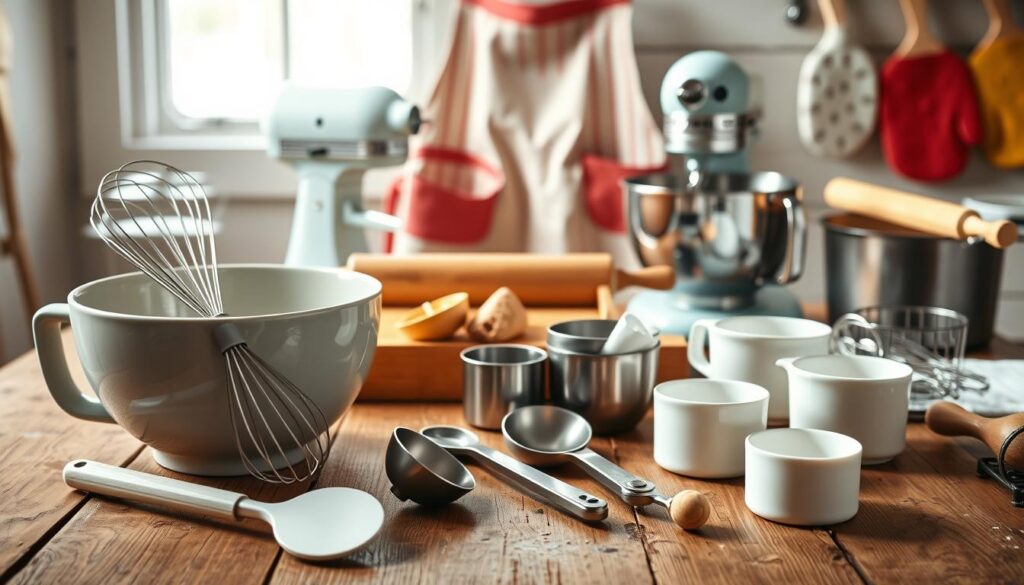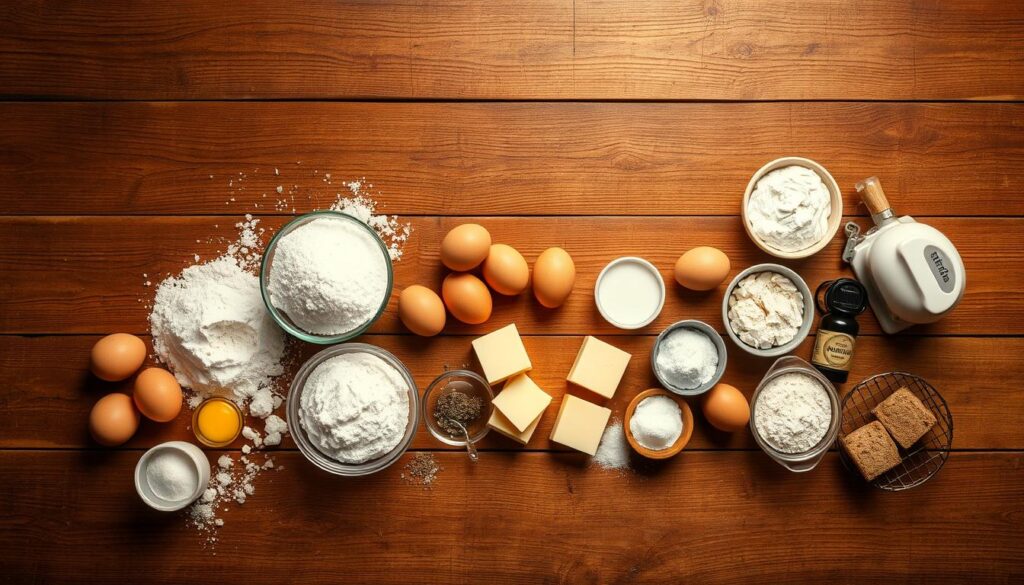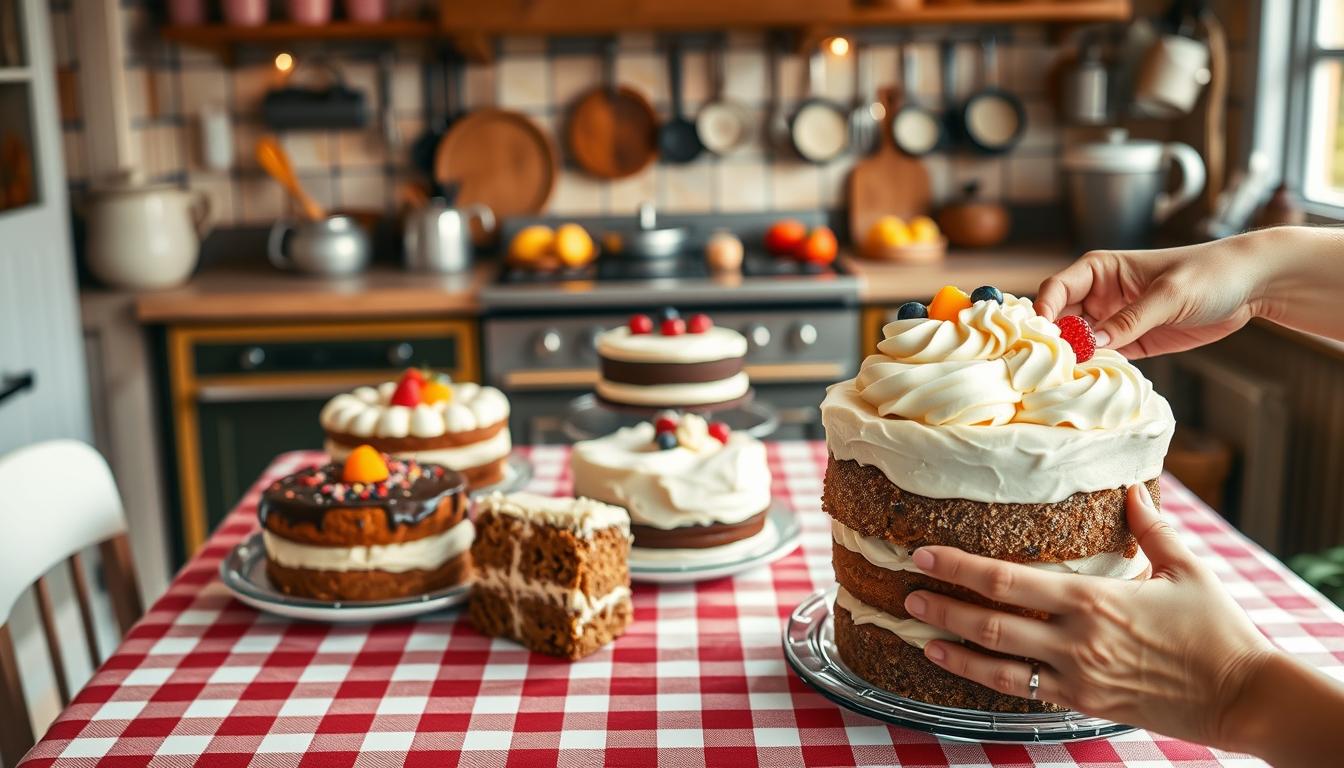Baking a homemade cake can be a delightful experience, especially when following simple and easy-to-understand steps. With a few basic ingredients and a straightforward cake recipe, you can create a delicious treat that’s sure to impress family and friends.
The joy of baking cakes lies in the process, from mixing the batter to watching your creation rise to perfection in the oven. By following a reliable cooking cake guide, you can achieve professional-tasting results without the need for extensive baking experience.
Key Takeaways
- Simple steps make baking a homemade cake easy and enjoyable.
- A basic cake recipe is all you need to get started.
- Baking cakes can be a fun and rewarding experience.
- Following a reliable cooking cake guide ensures professional-tasting results.
- With practice, you can become a skilled baker.
The Fundamentals of Successful Cake Baking
The key to successful cake baking lies in understanding the science and ingredients that come together to create the perfect treat. Cake baking is a precise process that involves more than just mixing ingredients together; it’s about creating a harmonious balance that results in a delicious and visually appealing cake.
Understanding the Science Behind Perfect Cakes
The science behind cake baking is rooted in the chemical reactions that occur between ingredients. Leavening agents, such as baking powder and baking soda, release gases that cause the batter to rise, giving the cake its light and fluffy texture. Understanding these reactions is crucial for achieving the perfect cake.
Must-Have Ingredients for Quality Homemade Cakes
To bake a quality homemade cake, certain ingredients are essential. These include high-quality flour, sugar, and eggs. The type and quality of these ingredients can significantly affect the final product. For instance, using cake flour instead of all-purpose flour can result in a tender crumb.
| Ingredient | Function |
|---|---|
| Flour | Provides structure |
| Sugar | Adds sweetness and tenderness |
| Eggs | Binds ingredients and adds moisture |
As renowned pastry chef, Rose Levy Beranbaum, once said, “The quality of the ingredients is crucial in baking, as it directly affects the final product.” This emphasizes the importance of selecting the right ingredients for your homemade cake recipe.
Essential Equipment for Cooking Cake at Home

The right equipment can make all the difference when it comes to baking a delicious homemade cake. To ensure your cake baking experience is both enjoyable and successful, it’s crucial to have the right tools and equipment.
Basic Tools Every Cake Baker Needs
To start baking, you’ll need some basic tools. These include:
- Mixing bowls for combining ingredients
- Measuring cups and spoons for accurate measurements
- Electric mixer (handheld or stand) for mixing batter
- Baking pans to shape your cake
These essentials will help you prepare a variety of cakes with ease.
Optional Equipment to Elevate Your Baking
For those looking to elevate their baking, consider investing in:
- Stand mixer for heavy-duty mixing
- Cake decorator for creative designs
- Oven thermometer to ensure accurate oven temperature
These optional tools can enhance your baking experience and provide more flexibility in your recipes. With the right equipment, you’ll be well on your way to mastering easy cake baking and applying valuable baking tips.
Mastering Cake Ingredients and Their Functions

To bake a great cake, it’s essential to know the role of each ingredient. The quality and characteristics of your cake depend heavily on the ingredients you choose and how they interact with each other.
The Role of Flour, Sugar, and Leavening Agents
Flour provides structure to your cake. Different types of flour, such as all-purpose, cake, or bread flour, have different protein contents that affect the texture of your cake. Sugar not only adds sweetness but also plays a role in browning and tenderizing the crumb. Leavening agents like baking powder and baking soda are crucial for the cake to rise. They release gases that get trapped in the batter, causing it to expand.
- Flour: Provides structure and texture.
- Sugar: Adds sweetness, aids in browning, and tenderizes.
- Leavening Agents: Help the cake rise.
Fats, Liquids, and Flavor Enhancers
Fats, such as butter or oil, contribute to the moistness and flavor of the cake. Liquids, including eggs, milk, or water, help to hydrate the flour and other ingredients, creating a cohesive batter. Flavor enhancers like vanilla extract or cocoa powder add depth and complexity to your cake. Using the right balance of these ingredients is key to achieving a moist and flavorful cake.
- Fats: Contribute to moistness and flavor.
- Liquids: Hydrate ingredients and create a cohesive batter.
- Flavor Enhancers: Add depth and complexity.
By understanding the functions of these ingredients, you can make informed decisions when substituting or adjusting ingredients to achieve the desired outcome in your cake baking, whether you’re looking for tips on moist cake tips or techniques for cake decorating.
Step-by-Step Cooking Cake Process
Baking a cake can be a straightforward process if you follow a cake baking guide. Start by preheating your oven to the right temperature, usually between 325°F to 375°F, depending on the recipe.
Prepare your ingredients according to the recipe, ensuring they are at room temperature. This helps in achieving a smooth batter. Mix the ingredients in the right order, typically starting with dry ingredients like flour, sugar, and leavening agents, then adding fats, liquids, and flavor enhancers.
Pour the batter into a greased and floured pan, and bake for the recommended time. Keep an eye on the cake, as oven temperatures can vary. Once done, let the cake cool in the pan for a few minutes before transferring it to a wire rack to cool completely.
By following these steps and tips from a reliable cake baking guide, you can avoid common mistakes and achieve a delicious homemade cake. Practice makes perfect, so don’t be discouraged by initial failures.
FAQ
What is the best type of flour to use for baking a cake?
All-purpose flour is generally the best choice for cake baking, as it provides the right balance of structure and tenderness. However, cake flour can be used for a more delicate crumb.
How do I ensure my cake is moist and not dry?
To keep your cake moist, make sure to not overmix the batter, use the right ratio of sugar and liquid ingredients, and avoid overbaking. Using ingredients like sour cream or Greek yogurt can also help retain moisture.
Can I substitute butter with oil in cake recipes?
Yes, you can substitute butter with oil in some cake recipes, but keep in mind that oil can change the texture and flavor. It’s best to use a neutral-tasting oil like canola or grapeseed oil.
How do I prevent my cake from sinking in the center?
To prevent a cake from sinking, ensure that your leavening agents are fresh, don’t open the oven door during baking, and avoid overmixing the batter. Also, make sure your ingredients are at room temperature.
What’s the best way to store leftover cake?
To keep leftover cake fresh, store it in an airtight container at room temperature for up to three days or wrap it tightly and freeze for up to three months.
Can I bake a cake in a microwave?
While it’s possible to bake a cake in a microwave, it’s not recommended as it can result in an unevenly cooked cake. Conventional ovens provide more consistent heat and better results.
How do I adjust a cake recipe for high altitude?
When baking at high altitude, you may need to adjust the recipe by increasing the liquid content, decreasing the leavening agents, and increasing the oven temperature. The exact adjustments will depend on the specific altitude and recipe.
